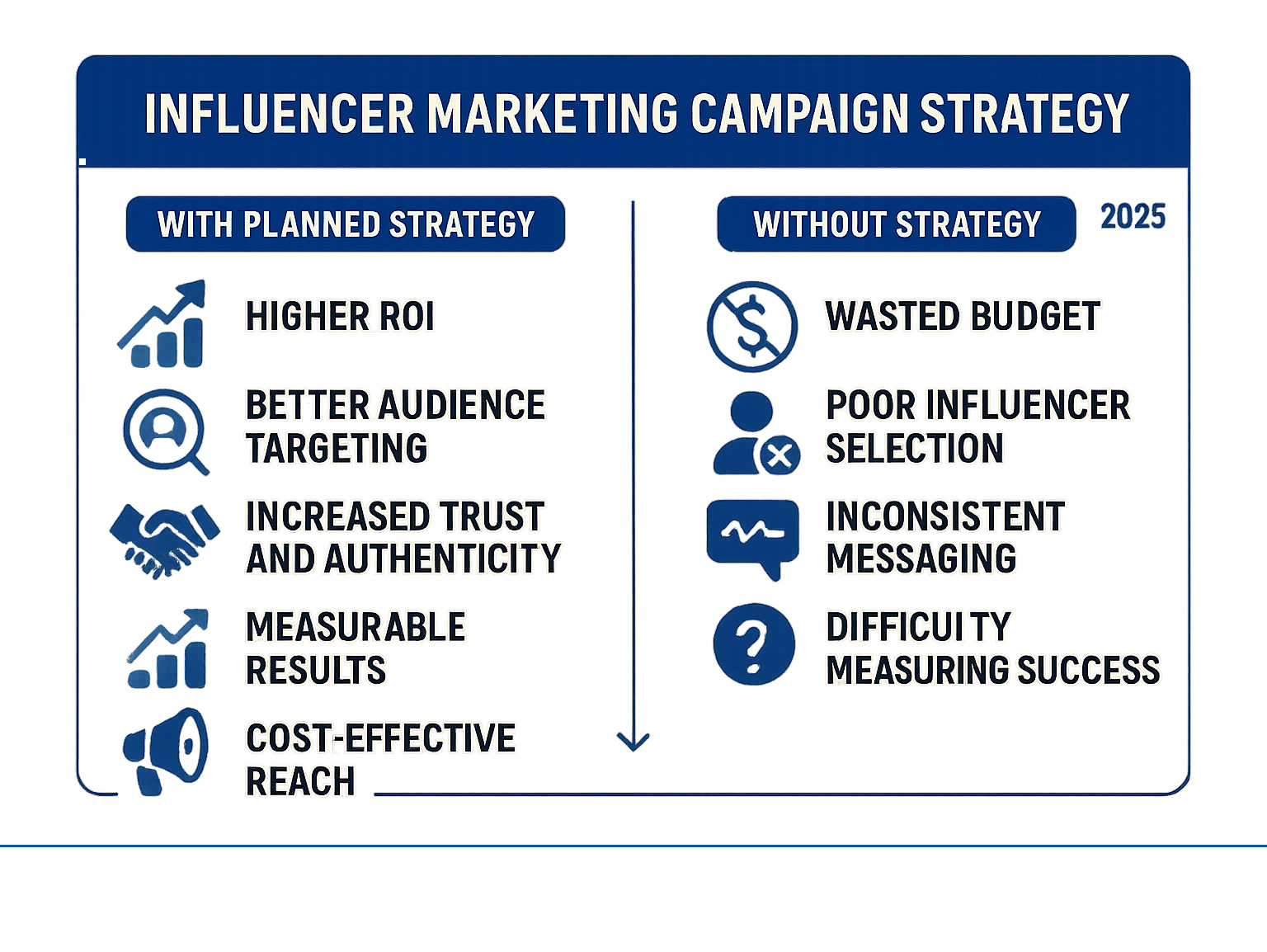Why an Influencer Marketing Campaign Strategy is a Game-Changer for Your Brand
An influencer marketing campaign strategy is your roadmap to partnering with content creators who can authentically promote your brand to their involved audiences. Here's what every successful strategy includes:
Essential Components:
- Clear goals and KPIs - Define what success looks like (brand awareness, sales, traffic)
- Budget planning - Account for influencer fees, product costs, and platform expenses
- Influencer selection - Choose creators whose audience lines up with your target market
- Campaign execution - Manage contracts, content guidelines, and FTC compliance
- Performance tracking - Measure ROI through interaction, conversions, and brand lift
The numbers tell a compelling story. The influencer marketing industry is projected to hit $24.1 billion by 2025, with brands earning $5.20 for every $1 spent when they have a clear strategy in place. More importantly, over 80% of consumers have bought something based on an influencer's recommendation, while 92% trust peer recommendations over traditional advertising.
But here's the catch - 43% of brands lose money on influencer marketing without a proper strategy. The difference between success and failure isn't just about finding popular creators. It's about building authentic partnerships that resonate with your audience and drive measurable results.
"Everyone can have influence, but not everyone can be an influencer," as one industry expert puts it. The key is finding creators who naturally line up with your brand values and can genuinely connect with their followers about your products.
I'm Steve Pogson, and for over two decades, I've helped e-commerce businesses build marketing strategies that turn browsers into buyers. I've seen how a well-planned influencer marketing campaign strategy can boost brand awareness and drive growth for businesses ready to move beyond traditional ads.

Basic influencer marketing campaign strategy glossary:
- how to create a successful digital marketing campaign
- campaign management in digital marketing
- how to measure the effectiveness of a digital marketing campaign
Understanding the Different Types of Influencers
When I talk about influencers, I'm not just talking about celebrities. The world of influence is vast and varied, categorized primarily by audience size, though interaction and niche relevance are often more important than follower count alone. Knowing the different types helps you pick the right partners for your influencer marketing campaign strategy.
| Influencer Type | Follower Count | Typical Interaction Rate | Best For |
|---|---|---|---|
| Nano-influencers | 1,000-10,000 | 4-8% (highest) | Highly niche audiences, authentic peer recommendations, local businesses, building long-term relationships, cost-effective campaigns. |
| Micro-influencers | 10,000-100,000 | 2-5% (strong) | Balancing reach and interaction, specific product reviews, targeted campaigns, startups seeking credibility. |
| Macro-influencers | 100,000-1,000,000 | 1-2% (moderate) | Rapid exposure, brand awareness on a larger scale, product launches, reaching broader audiences quickly. |
| Mega-influencers | 1,000,000+ | <1% (lowest) | Massive reach, celebrity endorsements, global campaigns, luxury brands, general brand awareness. |
It might surprise you, but nano-influencers are gaining significant traction. In 2024, 44% of brands preferred to partner with nano-influencers, a rise from 39% in 2023. Why? Because these smaller creators often have highly interactive, passionate communities who genuinely trust their recommendations. Their relatability makes their endorsements feel like a friend's advice, which is incredibly powerful.
The Power of Word-of-Mouth in the Digital Age
Think about it: who do you trust more? A glossy ad or a friend who's tried a product and raves about it? Most people agree. Consumers are 92% more likely to trust their peers over traditional advertising. This is a basic change in how people find and decide what to buy.
Influencers, especially smaller ones, feel like those trusted friends. They build credibility by creating content that connects with their audience. When they recommend a product, it feels like an authentic suggestion, not a sales pitch. This is especially true in niche communities where influencers are seen as experts.
This trusted recommendation stands out from traditional ads. It builds brand awareness and real connections, which is why it's a key part of your influencer marketing campaign strategy. It’s all about building trust. To learn more about how this affects your visibility, check out More info about Brand Awareness Marketing Campaigns.
Building Your Influencer Marketing Campaign Strategy Step-by-Step
A strong influencer marketing campaign strategy isn't about randomly sending products to popular people. It's a process that needs clear planning and execution. Here are the key steps I use with my clients to set up every campaign for success.

Step 1: Set Clear Goals and KPIs
Before finding an influencer, know what you want to accomplish. Is your goal to announce a new product, drive traffic to your Shopify store, or get more sales? Knowing your goals is the most important part of any successful campaign.
Here are some common goals and the Key Performance Indicators (KPIs) to measure them:
- Brand Awareness: You want more people to know about your brand.
- KPIs: Reach, Impressions, brand mentions, new followers, and new website visitors.
- Website Traffic: You want more visitors to your online store.
- KPIs: Click-Through Rate (CTR), website sessions, pages viewed, and Bounce Rate.
- Sales and Conversions: Your aim is for people to buy your products.
- KPIs: Conversion Rate, revenue generated, Average Order Value (AOV), and Customer Acquisition Cost (CAC).
- Lead Generation: You want to collect contact information from potential customers.
- KPIs: Number of new leads and Cost Per Lead (CPL).
- Audience Growth: You want your social media following to grow.
- KPIs: New followers and their interaction rate.
To better understand who you're trying to reach, take a look at More info about your Target Audience. Your goals should be SMART: Specific, Measurable, Achievable, Relevant, and Time-bound. This clarity will direct every step of your influencer marketing campaign strategy.
Step 2: Plan Your Budget
Budgeting for influencer marketing is key to getting the most from your spending. You need to account for several costs beyond just the influencer's fee.
- Influencer Compensation: Fees vary by influencer size, platform, and content type. A single post costs less than a video series. Smaller influencers might accept free products, while mega-influencers command high fees.
- Product Seeding Costs: Include the cost of products, shipping, and special packaging.
- Platform Fees: Account for fees if you use an influencer marketing platform.
- Content Rights: Agree on costs upfront if you want to use the influencer's content for your own ads or website.
- Paid Amplification: I suggest setting aside 10-20% of your budget to boost top-performing content with paid ads to expand your reach.
A clear budget helps you decide which types of influencers to work with. For a general idea of how influencer rates are set, you might find this helpful: A detailed breakdown of influencer rates.
Step 3: Find and Select the Right Influencers
Finding the right influencer is key. It's not about the most followers; it's about the right followers for your brand.
Here's how I approach it:
- Audience Demographics: Does their audience's age, gender, location, and interests match your ideal customer?
- Interaction Rate Analysis: I prioritize interaction over follower count. An influencer with 10,000 active followers is often more valuable than one with 100,000 passive ones. Check out More info about Interaction Rate.
- Content Match: Does their content style and quality match your brand's image?
- Brand Values: Ensure the influencer's personal brand and beliefs match yours to build trust and avoid problems.
- Vetting for Authenticity: Check for fake followers and artificial engagement. Look for sudden follower jumps or generic comments.
You can find influencers by searching hashtags on relevant platforms, or influencer marketing platforms can help. For more detailed guidance, this article can help: How to find the best fit for your brand.
Step 4: Manage Campaign Execution
Once you've chosen your influencers, it's time to manage the campaign. This stage requires clear communication and setting expectations.
- Creative Briefs: Provide a brief, not a script. It should include goals, key messages, brand rules, and important dates.
- Content Guidelines: Give clear "do's and don'ts" to maintain brand consistency.
- Giving Creative Freedom: Trust the influencer. They know their audience best. The most successful campaigns allow creators to be authentic.
- Contracts and Agreements: Always use a written contract. It should outline the scope of work, compensation, usage rights, exclusivity, timelines, and disclosure rules.
- FTC Disclosure Rules: Influencers in the US must disclose partnerships with #ad or #sponsored. This is a legal requirement that also builds trust. Make sure you're current with The FTC has updated its guidelines.
User-generated content (UGC) is a big part of this. Influencers often create amazing content that you can use again. For more on this, see More info about User Generated Content (UGC).
Measuring Success and Proving ROI
Launching a campaign is exciting, but the real test is measuring its success. This isn't just about counting likes; it's about seeing the real impact on your business goals.

Key Metrics to Track for Your Influencer Marketing Campaign Strategy
If you can't measure it, you can't improve it. That's why tracking the right numbers is so important. Here are the essential metrics I track:
- Reach and Impressions: Reach is the number of unique people who saw the content, while impressions are the total number of views. These metrics show your brand's visibility.
- Clicks and CTR (Click-Through Rate): These are vital for tracking website traffic. A high CTR means the content was compelling enough to make people click.
- Conversions and Sales: This tracks how many purchases or sign-ups came directly from the campaign, showing clear results.
- Cost Per Acquisition (CPA): This calculates how much it cost to gain one new customer from the campaign. Compare it to your other marketing channels.
- Return on Investment (ROI): This is the key metric. It calculates the revenue earned for every dollar spent. A good strategy aims for a positive ROI, with some brands earning $5.20 for every $1 spent.
- Brand Sentiment and Brand Lift: Sentiment tracks online conversations about your brand (positive, negative, or neutral). Lift measures improvements in brand recall and purchase intent, often through surveys.
Tracking these metrics helps you see what's working so you can improve future campaigns. For a complete guide on measuring your overall digital marketing, check out More info on How to Measure the Effectiveness of a Digital Marketing Campaign.
Tools for Tracking and Analysis
Accurate tracking is the backbone of proving your ROI. I use a mix of simple, effective tools:
- UTM Parameters: These are tags added to links that tell analytics tools like Google Analytics where your traffic is coming from. Give each influencer a unique UTM to track their performance separately. Use Google’s free UTM builder tool to create them.
- Unique Discount Codes: Give each influencer a special code (like "INFLUENCERNAME10"). When a customer uses it, you know exactly who sent them.
- Affiliate Links: These unique links track clicks and sales, often paying the influencer a commission.
- Dedicated Landing Pages: Create specific web pages for a campaign or influencer to easily track traffic and conversions from that source.
- Social Listening Tools: These tools monitor social media for mentions of your brand, campaigns, and hashtags to help you understand public sentiment.
How to Improve Your Next Campaign
A good strategy is never "set it and forget it." It's an ongoing process of learning and improving. After each campaign, analyze the data to make the next one stronger.
- Analyze Top Performers: Identify which influencers and content drove the best results and why. Do more of what worked.
- Gather Feedback: Talk to your influencers. Ask what they learned about their audience's reaction. Their insights are priceless.
- Test Different Platforms: If Instagram worked well, consider trying TikTok for short videos or YouTube for in-depth reviews to reach new audiences.
- Build Long-Term Partnerships: Lasting relationships with influencers feel more authentic and lead to better results over time. They can become true brand champions.
By constantly refining your approach based on data, you can keep improving your influencer marketing campaign strategy. For more tips on making your overall digital marketing stronger, check out More info on How to Optimize Digital Marketing Campaigns.
Common Mistakes to Avoid
Even with a solid plan, it's easy to make mistakes that cost time and money. Avoiding these common issues is as important as following best practices in your influencer marketing campaign strategy.

Focusing on Follower Count Over Interaction
This is the most common mistake. It's tempting to chase millions of followers, but reach without interaction is just a vanity metric. A high follower count doesn't guarantee a genuine connection or influence.
Some accounts have fake followers who won't buy your product or spread the word. What truly matters is an influencer's ability to connect with their audience and motivate them to act. This is reflected in their interaction rate—the likes, comments, and shares their content receives relative to their follower count.
This is why I often lean towards micro- and nano-influencers. Their smaller communities are often fiercely loyal and highly active, making their recommendations feel more like advice from a trusted peer.
Being Too Controlling with Content
You hire an influencer for their unique voice and trusted audience. Giving them a strict script is a mistake. This approach stifles creativity and makes content feel forced and inauthentic, which can damage both your brand and the influencer's credibility.
Instead, trust the influencer's expertise. Provide clear guidelines and key messages, but give them the freedom to weave those messages into their own style. Think of it as working together, not giving orders. Your brief should be a guide, not a cage. Explain your brand, audience, and product benefits, then let them be creative.
Neglecting Contracts and Clear Agreements
A handshake agreement isn't enough for a professional influencer marketing campaign strategy. Without a clear contract, you risk misunderstandings about deliverables and headaches down the road.
Without a contract, you also risk payment disputes. A contract clarifies payment terms. Crucially, it must state content usage rights if you want to reuse their content in your own marketing, which protects you from copyright issues. An exclusivity clause can also prevent them from promoting a competitor during your campaign. A well-drafted contract protects both parties and your investment in your influencer marketing campaign strategy.
Frequently Asked Questions about Influencer Marketing
It's natural to have questions about influencer marketing. Here are answers to some of the most common ones.
How much should I pay an influencer?
There's no single price tag for an influencer. Pay depends on their tier (from nano to mega), the platform (a YouTube video costs more than an Instagram Story), and the deliverables (the number and type of posts). Reusing their content for your own ads also typically costs extra.
Payment options vary. Some influencers prefer a flat fee, while others might accept free products (gifting), especially for smaller campaigns. There are also commission-based models where they earn a percentage of sales, or a hybrid model that combines a fee and commission. My best advice? Always negotiate based on your budget and the value the influencer provides.
What platform is best for influencer marketing?
The best platform depends on where your Target Audience spends time and what you want to accomplish. Here are a few popular choices:
- Instagram is still a huge player, perfect for visual products and building a lifestyle brand.
- TikTok is great for short, attention-grabbing videos, especially with younger audiences.
- YouTube is fantastic for in-depth content like detailed reviews and how-to guides.
- Facebook can help build communities and reach specific age groups.
- Pinterest is a gem for visually-driven products like home decor, as users are often ready to buy.
- LinkedIn is increasingly useful for B2B needs and finding thought leaders.
The key is to go where your ideal customers are and where your product can shine.
How long does it take to see results from an influencer campaign?
How quickly you see results can vary. Some results are immediate, while others take time to develop.
For brand awareness, you can see an almost immediate boost in metrics like reach and impressions as soon as a post goes live.
When it comes to sales and conversions, it might take longer. Customers often need time to consider a purchase. I suggest tracking sales over a few weeks or even a month after the campaign launches.
The real magic often comes from the long-term impact. Building lasting relationships with influencers leads to ongoing brand visibility, stronger customer loyalty, and a steady stream of sales. Patience and careful tracking are key to seeing the full picture.
Let's Build Your Winning Campaign
To sum up, a strong influencer marketing campaign strategy is a must-have. Think of it as your secret weapon to connect with people, stand out from the crowd, and get real results.
Every step matters: from knowing what you want to accomplish, to picking the right influencers, managing campaigns smoothly, and watching performance.
I've seen that brands who plan carefully—treating influencers as partners and aiming for real connection—are the ones that succeed. They don't just see a good return on their money; they also build lasting relationships with their audience. It's about more than just sales; it's about building a community around your brand.
If you're ready to create a powerful influencer marketing campaign strategy that turns casual visitors into loyal customers and helps your e-commerce business take off, my team at First Pier is here for you. We can help you plan, run, and improve your campaigns for true, measurable growth.
Get help with your marketing campaign strategy and management







